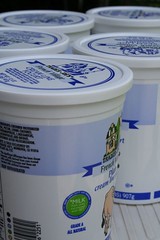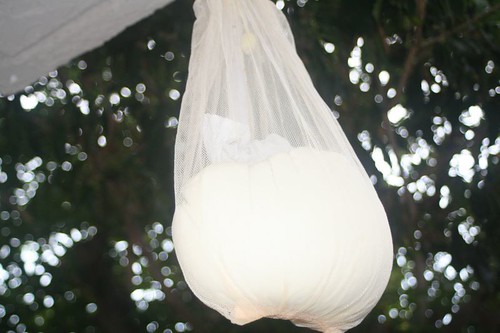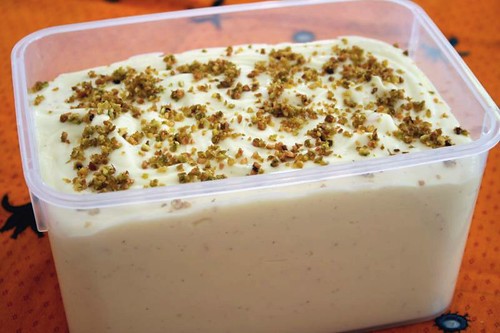
Last week, a bunch of friends decided to take advantage of the perfect weather and do a picnic lunch in a local park. Over a hundred e-mails flew around before the perfect final menu was planned. I had it easy; I was to take shrikhand. Easy, hnnn? Well, yes, if you consider the people who agreed to fry pooris for twenty people or make four pounds of aloo ki sabji. Some other things that people brought included a delicious fusion chaat, cucumber sandwiches, yogurt rice, coconut cilantro chutney, and fresh fruit. The spread that resulted is one that I will remember for a long time. Did I mention some pink lemonade with gin?
Recently, I came across something interesting - in K T Achaya's 'Indian Food: A Historical Companion', there is a mention that shrikhand as we know it now, appeared in writings on food in Kannada as early as 1025 AD. It refers to 'Lokopakara' of Chavundaraya which says that it was known as shikarini at that time. After that 'Supa Shastra' by the poet Mangarasa refers to shrikhand in 1594 AD, so the new name seems to have caught on at least by then.
I would like to know how shrikhand eventually became such a popular Maharashtrian dessert. It used to be really common at wedding lunches. How I hated it then! It was usually served with great 'Agraha', basically a sweet form of force feeding, by the bride and groom and their family members. It has been so many years since I attended a wedding in India, and even longer where shrikhanduh (as it is pronounced) was served, but those memories still make me shudder. The other thing that was popular was jilebi, and I developed the same type of antipathy towards those too. Even now, these are nowhere near to becoming my favorites, but I eat them occasionally.
Shrikhand is best served cold, so it naturally lends itself to be made ahead of time. Here is how I make it, using the classic method and ingredients, and even a past shrikhand hater like me likes it this way.
The traditional version
 2 lbs plain yogurt (refrain from the lower fat varieties)
2 lbs plain yogurt (refrain from the lower fat varieties)1/2-3/4 cup confectioners sugar (upto 1 cup if you like it to be very sweet)
5 green cardamom pods (elaichi)
about 1/4 teaspoon saffron
1 Tablespoon milk
1-2 Tablespoons of chopped unsalted pistachios, slivered almonds, or charoli, or a combination of it
Pre-preparation for chakka
Make sure there is some place from where you can hang 2-10 lbs of weight, and allow the water to fall. I usually hang it on a hook on the patio and let it sit there overnight, preferably on cool nights. You also need a large piece of cotton or muslin cloth, about as thick as a dupatta. I have a large piece of 'flour sac' material that I have reserved specifically for shrikhand.
Working near the sink, lay the cloth in a large wide bowl, and empty the yogurt into it. Pull up the corners to make a bundle, over the bowl. Water from the yogurt will start streaming out. Tie a rubber band to secure the bundle if required. Squeeze gently to allow more water to fall. Now hang this bundle from the hook, keeping the bowl as close to it as possible. I have a net bag in which I place the bundle. I like to let this sit overnight. The end result of this is the residual yogurt with very little water and called 'chakka' in marathi.

Making the shrikhand
When you are ready to make the shrikhand next morning, gently heat the milk just enough to warm it, and stir in pinches of crumbled saffron into it. Let it sit for atleast half an hour. Peel the cardamom and powder the seeds finely using a mortar and pestle.
Squeeze out as much water as you can from the yogurt bundle. The more water you can get out, the better the consistency. Carefully open the bundle, and spoon out the creamy yogurt into a big bowl. Stir in the sugar into the yogurt, along with the cardamom and saffron milk. Stir everything with a large spoon to mix evenly.

Garnish with pistachios and almonds if you like. The saffron and nuts are optional, but I love to use both, and particularly pistachios.
A large batch packed up to be taken to the picnic.

Variations with Fruits
The most popular variation on shrikhand is Amrakhand, which is made by mixing in a puree of ripe mangoes into the rest of the ingredients. Sometimes other types of fruit are also added but these versions are not as popular or common.
When I think of the abundance of fruit here, strawberry shrikhand and peach shrikhand come to my mind as variations. Almost any sweet fruit that can get slightly mushy when ripe could also be considered. Like the blackberry shrikhand that Manisha made recently. However, everytime I think of trying out a fruit variation, the majority vote goes in favor of the classic.
Kesar Shrikhand
Instead of using just 1/4th teaspoon saffron, use 1 teaspoon of it, for a shrikhand with a strong saffron flavor and lovely golden color.



























14 comments:
this was great - thanks! now that you make it sound so deceptively simple, i feel foolhardy enough to actually try it at home.
simple but sweet ....great one ..thks for sharing
Nice writeup.
I, too, hated shrikhanda growing up. But now I look for any excuse to make it; the classic way, always.
Looks good. Yeah, it goes really well with puris.
nsg, go for it, and let me know how it turns out. It is quite hard to go wrong, and as a bonus, you will get some easy workout for the upper arms too.
deepa, lata, thanks, and welcome to the blog!
cooker, hi again. It wasn't just me, most of my cousins didn't like shrikhand either. I think it was the sourness of the yogurt that got even more sour after sitting for several hours in the hot weather that made me dislike it. Here, I chose a yogurt that is as non-tart as possible, and make the chakka only when the temperatures are low, which helps a lot.
Looks yummy! I will be making it the traditional way next.
If you want to try the fruit shrikhand, keep some of the chakka+sugar mixture aside. Give the others what they want and try it out with some delicious fruit!
Glad your picnic was so much fun!
that looks great!! I do love the shrikhand-puri combo...a classic.
i love this combo with puris. i too dislike it when it gets sour. Now i tie the mulin cloth and refrigerate it so that it does not get sour. by the way great writeup!
Yum, having had the real thing that day, seeing this process is like having it all over again.
Manisha, give the kesar elaichi version a try, arre atleast for the sake of your husband. You can add blackberries to your portion. :-)
Thanks, Trupti. btw, I love the seeing the sarees that you display on your blog.
Thanks Roopa, and hello again too.
desiknitter, it was a fun outing for me after a long time. After you return let us have another shrikhand session!
I looked at your Shreekhand recipe before venturing into it. This along with two valuable additions from other places - greek yogurt (I found a brand called "Fage") and cheese-cloth for chakka bandhne led to mmmm delicious Shreekhand.
I had a similar experience - hated it and "aagraha" growing up but all I could think of this Diwali was Shreekhand and how I could package it up and mail it to friends and family staying in other parts of this country (which I did!).
Mithila, that is so nice to hear! Responses like this really bring great joy to me. I am sure your friends and family are thanking you for your gifts. Fage is indeed quite good, as are other greek-style yogurts, though sometimes too decadent for everyday use. :-)
Post a Comment